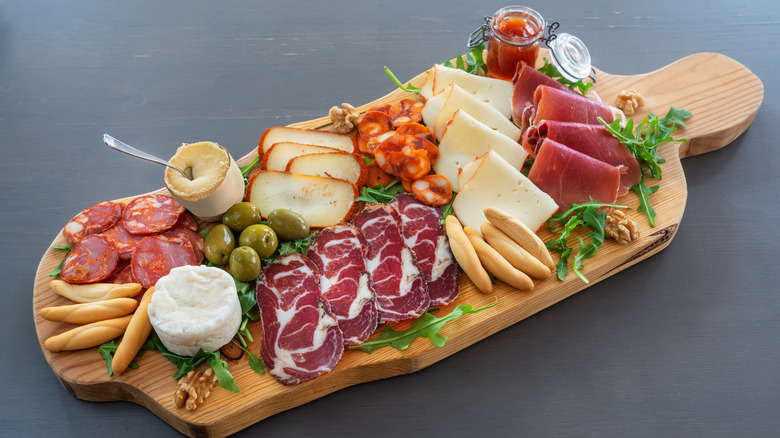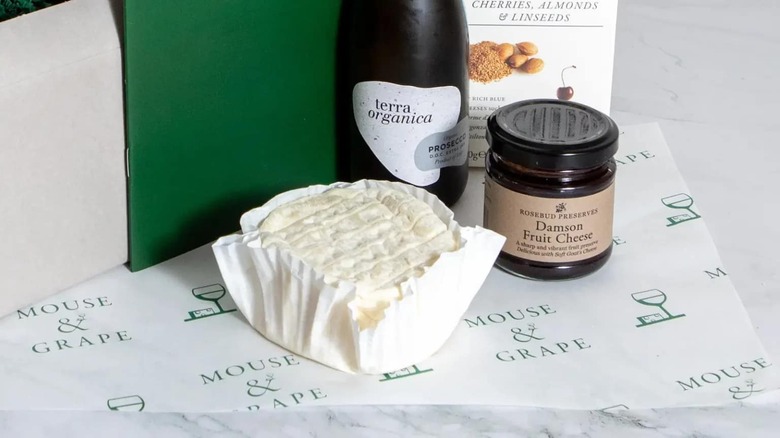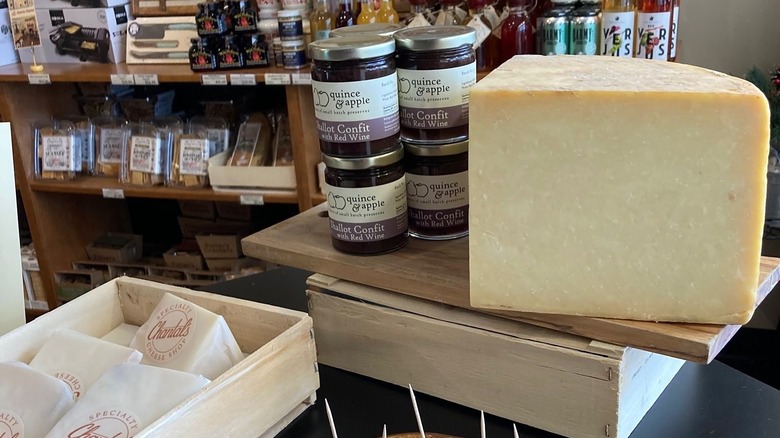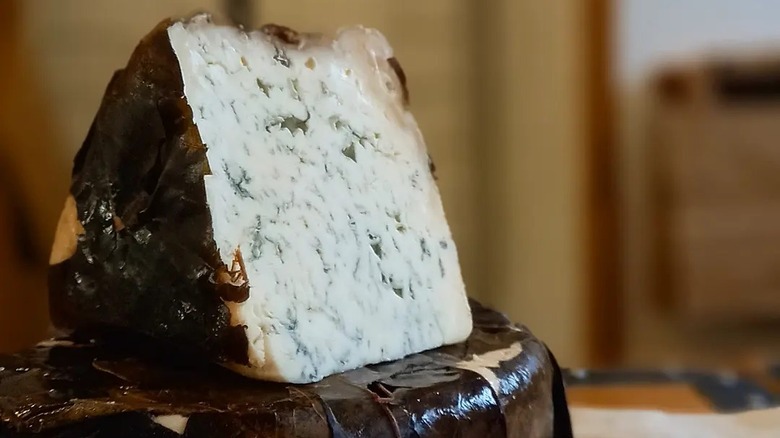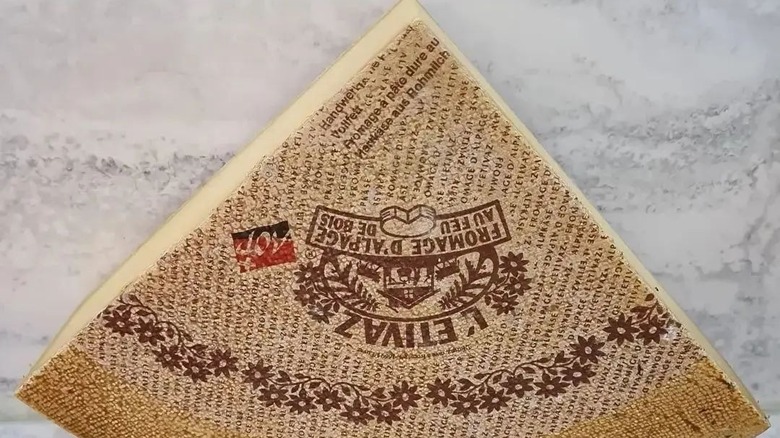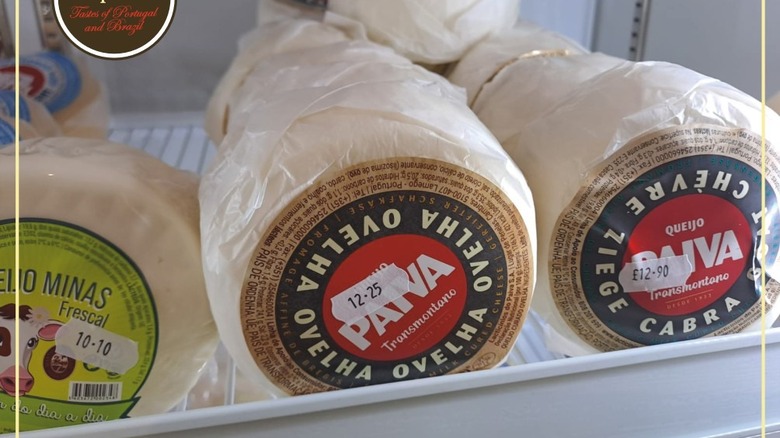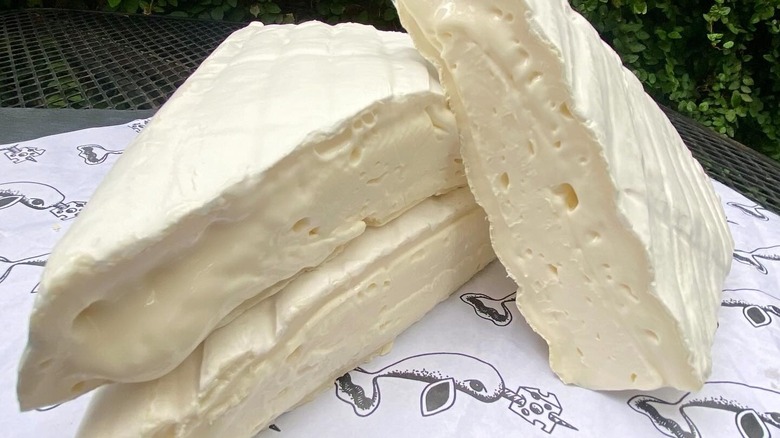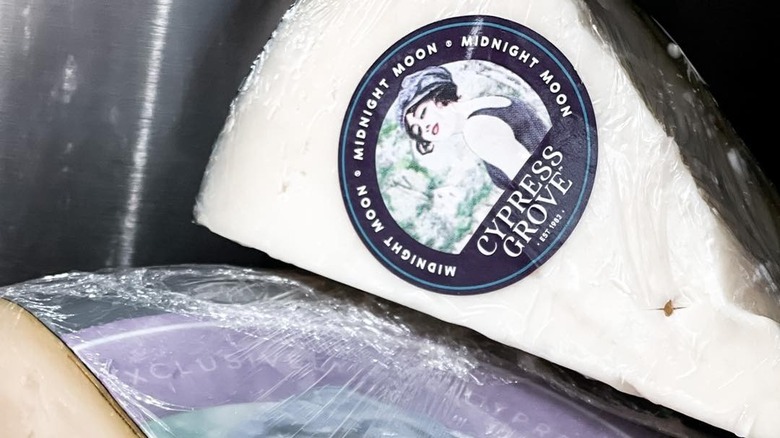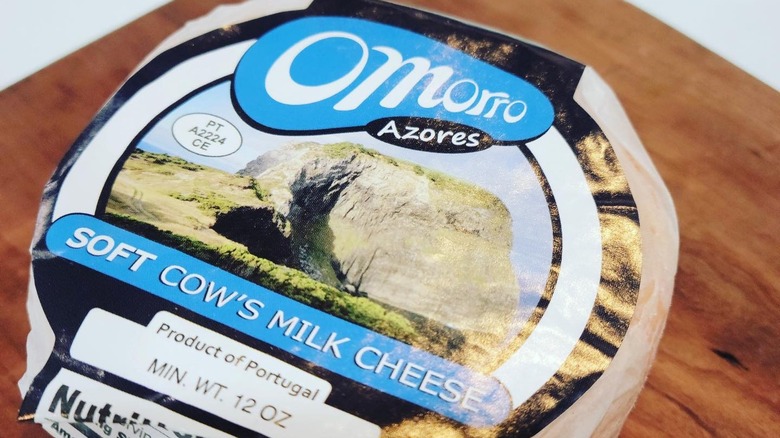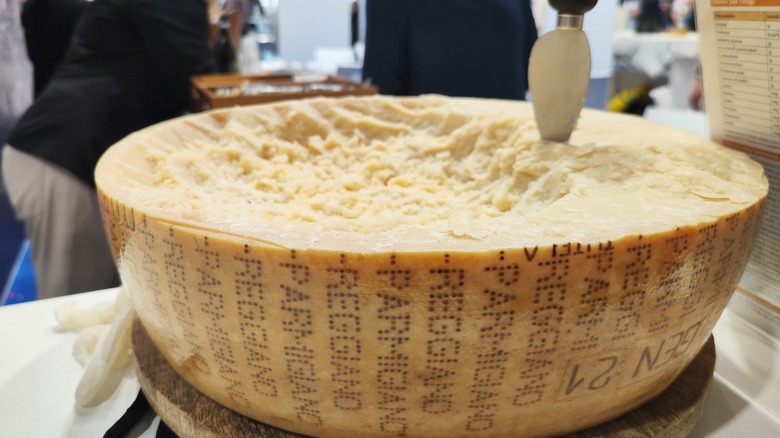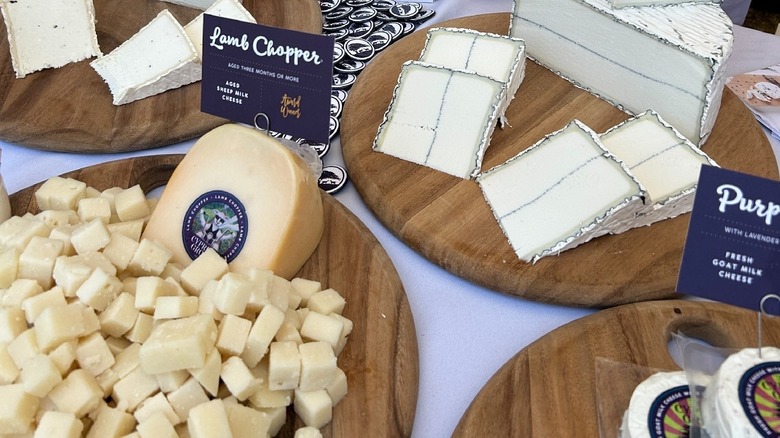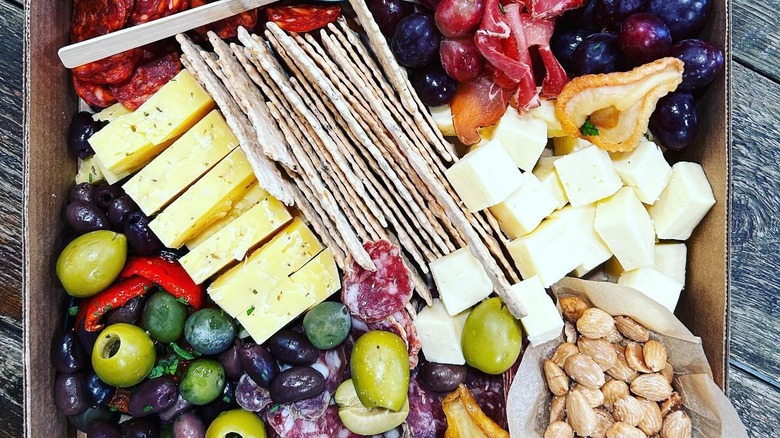11 Types Of Cheese To Elevate Charcuterie Boards, According To Experts
An elegant charcuterie board can be the perfect party platter and is a delicious option for a light lunch. Cheese is a vital part of any charcuterie spread and provides a creamy counter-balance to salty snacks, like cured meats and olives, or to sweet elements, like fruits and chutneys. To learn more about selecting cheese for your charcuterie platter, we spoke to experts Chef Melissa Lopez and Matthew Rose. Melissa Lopez is a chef-partner at Barra Santos, which is a James Beard 2024 Best New Restaurant semi-finalist, while Matthew Rose is a Partner at the Fairfield and Greenwich Cheese Company.
Lopez notes that when she curates a board she's "always looking for varied flavor and texture profiles." The blend of crunchy nibbles and smooth creamy cheeses is one of the things that makes charcuterie boards so irresistible and keeps you going back for more. Lopez also cautions against using a "super funky cheese" on your board as they "can overwhelm the palette." These 11 cheeses are the perfect mix of mild yet complex to complement a pro charcuterie spread.
1. La Tur
La Tur is an Italian soft cheese that is made with a mixture of cow, goat, and sheep's milk. Manufactured in Italy's northern Piedmont region, La Tur is similar to French brie in taste, texture, and in its production process. Melissa Lopez states that she likes to put La Tur on a charcuterie board because it "has a little funk to it" and is "creamy enough to eat with a breadstick." Perfect if you're setting up a platter with lots of crunchy dipping crackers.
La Tur's mild yet earthy flavor profile is often described as rich with a buttery creme fraiche texture, mushroom notes, and a slightly acidic, tang. Like brie, La Tur is a bloomy-rinded or mold-ripened cheese. This means that bacteria cultures are added to the cheese curds before they set and, during the 10-15 day aging process, an edible mold rind blooms and covers the cheese surface. La Tur usually has a slightly wrinkled outer texture and is molded into small, dainty wheels that fit perfectly on a sharing platter.
This tasty Italian cheese usually retails for between $15 to $33, although this price varies with size and quality. You can buy La Tur in most high-quality cheese shops and at Kroger. To keep this cheese fresh, it's best to store it in the fridge.
2. Cabot Clothbound Cheddar
A hard cheese can work great alongside creamier cheeses if you want to add some texture to your charcuterie board. Matthew Rose recommends Cabot Clothbound Cheddar for its delicious flavor, which "has a brothy savoriness balanced with the sweetness of caramelized nuts." Cabot Clothbound Cheddar developed out of a collaboration between renowned Vermont cheese producers at the Cabot Creamery Cooperative and Jasper Hill Farm. The cheddar is made from pasteurized cow's milk from Vermont farms and is aged for 9-14 months inside the Jasper Hill Cellars, which are designed to mimic the natural cheese cave environment associated with ancient rind cultivation techniques.
Like most cheddars, Cabot Clothbound is a firm cheese that's made by adding bacterial cultures and rennet to milk and then separating the curds from the whey. The curds are repeatedly pressed to release moisture and are molded into wheels. These wheels are bound tightly in cloth and coated with lard to prevent moisture from escaping while they age and to encourage bacterial growth, which gives the cheese flavor. Cabot Clothbound Cheddar is a mature cheese, meaning that it has a longer aging process than mild cheddars and has a stronger, sharper flavor as a result.
You can find Cabot Clothbound Cheddar in many artisanal cheese shops. It generally costs around $32 for a 1-pound piece and should be kept in the fridge to further support its long shelf life.
3. Valdeón
Noting her preference for cheeses made from "varied milk types" on charcuterie boards, Melissa Lopez recommends Valdeón – a blue cheese from North Spain that's made from a blend of cow's and goat's milk. Lopez also observes that Valdeón is a good option for sharing platters because "it's a middle-of-the-road blue cheese which makes it approachable to many people." Approachability is an excellent quality for a blue cheese as some people can be put off by the strong flavors and the visible mold that gives blue cheese its title.
Valdeón has a sticky, crumbly texture and a slightly sweet flavor that's balanced by the fresh, zingy goat's milk. Native to the Castile and Leon Spanish region, Valdeón has protected EU status and can only be produced in this area. Like other blue cheeses, Valdeón is made by introducing blue mold cultures – penicillium roqueforti – to cheese curds. As the cheese ages, the mold spreads through it creating a blue, marbling pattern.
To give Valdeón its unique look and scent, the cheese wheels are wrapped in a rind of sycamore leaves before being left to age. This rind is removed before consumption but infuses the cheese with an earthy, almost leathery aroma. If you're planning to make Valdeón the blue cheese on your charcuterie board, Lopez adds that it "goes great with charred tomatoes marinated in fresh thyme" or with "Spanish chorizo." Valdeón can be purchased at most high-quality cheese shops for around $22 to $23 per pound.
4. L'Etivaz
L'Etivaz is a truly unique cheese and is perfect if you're looking for something niche to elevate your charcuterie board. Matthew Rose describes this mountain cheese as a "true gem" — it "is made in Switzerland and can only be produced using raw cow's milk during the summer, while the cows graze on high-mountain pastures" of the Alpine region near Etivaz town. Traditionally, l'Etivaz is made by heating milk over an open fire, adding bacterial cultures and rennet, and then simmering until the curds solidify. The curds can then be pressed and aged for at least one year in the Etivaz cave, which is used collectively by all the local l'Etivaz producers.
This rustic cheese has a firm texture that is similar to other Swiss cheeses, like Comte or Gruyere. The raw cow's milk gives it a vaguely grassy taste, while the open-fire cooking method infuses the cheese with a smoky flavor. It is also known for having a melted caramel sweetness that's brought out when the milk is heated.
Given its limited production season and the small number of producers, l'Etivaz can be hard to find and has protected status under French law to prevent it from being made elsewhere. To buy l'Etivaz, you will have to shop at specialized cheese shops and spend around $20 to over $30 per 1-pound piece.
5. Olveha (Alvelhe)
Olveha or Alvelhe is a Portuguese cheese made from a mix of cow's and sheep's milk. "It's a great addition to a board," Melissa Lopez tells us. According to Lopez, this cheese has a "creamy, grassy, and buttery" flavor that pairs well with salty snacks, like olives and Iberico ham.
Portugal has a historic cheesemaking tradition and produces a wide range of local, farmyard cheeses. Olvehia or Alvelhe is made by Martins and Rebello – one of Portugal's oldest cheese producers — which is based in Ossela near the small town of Alvelhe in northern Portugal. You can also find pasteurized Portuguese brands of this unique cheese, however, it may be necessary to shop at delicatessens or specialty cheese shops to reliably source it. A small wheel will generally cost around $16 to $17.
Alvelhe is a soft cheese and has a smooth texture that's ideal for spreading on crackers or crispbreads. It can be stored in the fridge or a cool, dry room. For an ideal tasting experience, remove the wheel from the fridge and from its packaging around 30 minutes before serving to allow the cheese to breathe and warm up slightly.
6. Melinda Mae
Melinda Mae is a soft-ripened, bloomy-rind cheese with a white mold skin and an oozy, spreadable paste. Matthew Rose particularly recommends this cheese for a charcuterie board as "it has a rich, but not-too-rich, silky smooth texture elevated by a lively acidity," that "will leave you and your guests wanting more." Melinda Mae is a cow's milk cheese and was created by Brian Civitello of the Connecticut-based cheesemaking company, Mystic Cheese Co. Civitello was inspired by traditional Italian cheesemaking techniques and named the cheese after a poem by American author, Shel Silverstein, in which a girl named Melinda Mae gradually devours a whale.
The whale motif in the poem also features in the cheese's packaging, which is decorated with narwhals. The weighty rectangular blocks are perfect for slicing up to share and the cheese is known for having a light, fluffy consistency. To give Melinda Mae its rich, milky tang, Mystic Cheese Co. pasteurizes fresh milk directly from the cow, which helps preserve the dairy freshness before the mold cultures are added. It then matures for around one month to allow the cheese to ferment and the mold to bloom.
You can buy Melinda Mae at Mystic Cheese Co. for around $29.00 per 1 pound block. Melinda Mae is also available at a range of gourmet cheese retailers in and around the U.S.
7. Midnight Moon
Melissa Lopez describes Midnight Moon as an "easygoing hard cheese that everyone loves," making it a perfect addition to any charcuterie platter. Described by Lopez as an "aged goat cheese," Midnight Moon is a Dutch cheese that "goes great with all types of charcuterie accouterments." It's manufactured in Holland and distributed in the U.S. by the Cypress Grove dairy farm.
Midnight Moon has a pale, whitish paste and a mild, slightly sweet, almost nutty flavor. The texture is firm with a slight crunch due to protein crystallization that occurs during aging. This makes it great to pair with a soft, creamy cheese for balance on a charcuterie board. It's aged for at least six months and is sold in small wheels that are wrapped in black wax rind.
Midnight Moon is available to buy from Cypress Grove and other cheese retailers online for around $29 to $30 for a 1-pound block. If you're looking for cured meat to pair it with, Lopez recommends a "prosciutto" as "the saltiness of the ham goes great with the creaminess of the cheese."
8. Omorro Amanteigado
Omorro amanteigado is a soft Portuguese cheese that's great if you want a slightly stinky cheese on your sharing platter. Melissa Lopez sums up omorro as "creamy with a slight funk." Discussing omorro's place on charcuterie boards, Lopez observes that "you need something strong to stand up to this grassy with a medium funk cheese," suggesting "hard fennel salami" as a great pairing option.
Although it has the smooth, buttery texture shared by many Portuguese cheeses, omorro is also somewhat unusual in that it is a cow's milk cheese. Portuguese cheesemakers often favor sheep and goat's milk cheeses. However, omorro is manufactured on the Azores island of Faial, where there is a lot of high-altitude pasture land that's suitable for cattle. Omorro is made with pasteurized milk and is solidified using plant-based rennet.
The cheese wheels are then wrapped tightly in cloth to help the rind form and prevent moisture from escaping. Once the cheese is finished, the outer skin almost transforms into a natural dipping pot for the oozy, gooey paste within. Omorro can be found at specialty cheese shops and delicatessens and costs roughly $20 to $32 for a 1-pound piece.
9. Parmigiano Reggiano
If you love Italian food, you may have tasted Parmigiano Reggiano sprinkled over pasta or spaghetti dishes. However, Matthew Rose also recommends Parmigiano as a hard cheese option on a charcuterie board. According to Rose "high-quality Parmigiana Reggiano is a highly accessible delight" that features "flavors of chicken broth, fried almonds, and dried fruits and is one of the absolute best cheeses to serve alongside cured meats like prosciutto or sopressata."
Parmigiano is a cow's milk cheese that originates from northern Italy and is closely related to parmesan cheese. However, unlike parmesan, Parmigiano Reggiano has Protected Designation of Origin status and must be made in specific regions and only using certain techniques. In Europe, parmesan is considered interchangeable with Parmigiano Reggiano and must also come from Parmagiano regions.
Parmigiano Reggiano's deliciously complex flavor comes from its bespoke manufacturing process, which involves coagulating milk in copper pots and cutting the separated curds until they form into tiny granules. These granules are then collected into wheels, immersed in a salt bath, and aged for anywhere between one year and 40 months.
The final product is firm, rich, and salty and can be purchased in blocks from artisanal cheese sellers or grated in tubs from outlets like Kroger. For premium Parmigiano Reggiano that you want to serve in slices, you will usually have to pay at least $22 for a piece. Parmigiano Reggiano also goes up in price the longer it is aged.
10. Lamb Chopper
According to Melissa Lopez, Lamb Chopper "is a young sheep milk gouda" with a semi-firm consistency and a mild, sweetish flavor. Lopez notes that it pairs well with salty ham but that "fresh-in-season melon is also a great pairing." Lamb Chopper is produced in the Netherlands and distributed by California-based dairy farm and cheese company, Cypress Grove.
The cheese is made using pasteurized sheep's milk and is coagulated with plant-based rennet. It is then aged for around 3-6 months and develops a thin, wax rind. The paste is pale yellow and is known for having a creamy mouthfeel despite being a firm cheese.
As well as warm caramel notes, Lamb Chopper's flavor is often described as nutty and slightly sharp, although not as tart as mature cheddars. This makes it an ideal cheese for a mix-and-match charcuterie board where you don't want any one flavor to overwhelm the others. Lamb Chopper costs just under $30 for a 1-pound wedge through Cypress Grove's retail site, Gold Belly.
11. Malvarosa
If you love Spanish manchego, malvarosa — manchego's richer, creamier cousin — is a must-try addition to your charcuterie board. Melissa Lopez describes malvarosa as "similar to a manchego, but much richer in flavor" and notes that it "goes amazing with fruit condiments (fig jam or even a marmalade)" and with "Iberico ham."
Malvarosa is a semi-hard sheep's cheese and is made in Valencia on Spain's east coast. Traditionally, it is made exclusively with milk from rare Guirra sheep, which are only bred for this purpose. The milk is pasteurized before use and the cheese is wrapped in a cheesecloth and aged for at least three months. The end product is buttery and smooth with creamy toffee notes.
When storing your malvarosa cheese at home, it's a good idea to treat it the way you would manchego. This means keeping it in the fridge — wrapped in paper, ideally, not plastic — and placing it in a sealed container if it is near foods with strong odors to prevent these from interfering with the cheese's delicate aroma. To serve, you should take it out of the fridge an hour or two beforehand and let it come to room temperature. Malvarosa can be bought online and at various cheese delicatessens and costs approximately $14 to $24 per pound.
Methodology
This article was written using the expert advice of Melissa Lopez and Matthew Rose who gave us a rundown of their favorite cheeses to put on a charcuterie board. It also draws upon research from cheese blogs and online artisanal cheesemakers and cheese retailers.
